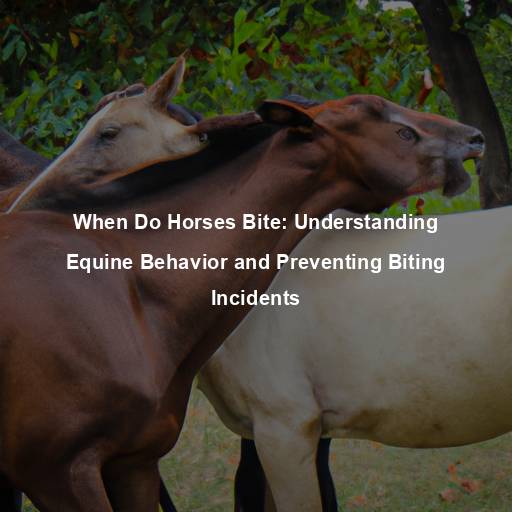When Do Horses Bite: Understanding Equine Behavior and Preventing Biting Incidents
Last Updated on July 31, 2023 by Evan
Contents
- 1 Understanding Horse Behavior: The Nature of Equines
- 2 Common Triggers for Biting Behavior
- 3 Preventing Biting Incidents: Building a Trusting Relationship
- 3.1 Provide Regular Veterinary and Dental Care
- 3.2 Use Proper Tack and Equipment
- 3.3 Implement Positive Reinforcement Training
- 3.4 Socialize Your Horse
- 3.5 Establish Clear Boundaries
- 3.6 Seek Professional Guidance
- 3.7 Ears Pinned Back
- 3.8 Raised Tail and Swishing Tail Movements
- 3.9 Aggressive Body Language
- 3.10 Nipping or Mouthing
- 4 Responding to Biting Incidents: Immediate Actions to Take
- 5 Deepening the Bond: Building Trust and Understanding
- 6 FAQs: When do horses bite
- 6.1 What situations may cause a horse to bite?
- 6.2 Do all horses have the potential to bite?
- 6.3 Are horses more likely to bite certain individuals?
- 6.4 Can horses bite out of playfulness?
- 6.5 How can biting behavior in horses be prevented?
- 6.6 What should I do if a horse attempts to bite me?
- 6.7 Can biting in horses indicate a health issue?
- 6.8 Are there any warning signs before a horse bites?
Understanding Horse Behavior: The Nature of Equines
Horses are magnificent creatures that have been domesticated for centuries, serving humans in various capacities ranging from transportation to companionship. However, it is essential to recognize that horses are still animals with their own instincts and behaviors. Understanding equine behavior is crucial for ensuring our safety and developing a harmonious relationship with these majestic animals.
The Equine Teeth: A Window into their World
To comprehend why horses bite, we must first delve into the anatomy of their mouths. Horses possess a set of strong, sharp teeth that serve different purposes. The incisors, located at the front of the mouth, are used for grabbing and cutting grass. The premolars and molars, situated at the back, are responsible for grinding food for digestion.
Equine Social Dynamics: The Herd Mentality
Horses are social animals that naturally live in herds, following a hierarchical structure led by a dominant individual. This social organization plays a significant role in their behavior, including the occurrence of biting incidents. Understanding the herd mentality can shed light on why horses may resort to biting.
In the dynamic world of herds, horses navigate intricate social hierarchies through a tapestry of interactions, marked by displays of dominance and physical exchanges. Among these intricate dynamics, biting emerges as a powerful tool for asserting influence and defining boundaries. However, it’s important to understand that horses might employ this rather blunt language of nipping or biting to communicate their emotions, be it frustration, fear, or even discomfort. Thus, deciphering their intricate lexicon remains an intriguing challenge to comprehend these enigmatic creatures.
Common Triggers for Biting Behavior
The equine world is a fascinating realm, where majestic horses reign supreme. However, even the calmest of these noble creatures can sometimes delve into an unexpected bout of biting. As horse-people, it is crucial for us to be well-versed in their triggers, so as to prevent any untoward incidents and ensure a harmonious and secure atmosphere. We must always be on the lookout, ready to decipher the enigmatic cues that unravel this peculiar behavior.
Pain or Discomfort
Just like us, our equine companions can also go through physical discomfort or pain. This discomfort can stem from a variety of factors like improperly fitted gear, dental problems, injuries, or underlying health conditions. When horses experience these painful sensations, they may resort to biting as a means to express their distress or safeguard themselves from further discomfort.
Fear or Anxiety
Horses, being naturally inclined as prey animals, possess a profound instinct to protect themselves. Consequently, when they encounter unfamiliar or distressing circumstances, it is not unusual for certain horses to exhibit anxious or fearful responses, resulting in potential biting tendencies. Ensuring a serene and stable setting becomes paramount in order to mitigate the likelihood of such fear-driven bouts of aggression.
Lack of Training or Socialization
When it comes to the fascinating world of horses, one thing is clear: training and socialization are the keys to unlocking their full potential. Picture this: a well-trained horse, gracefully prancing and obediently responding to its rider’s commands. But what about those unruly biters? Ah, yes, the result of inadequate training or a lack of exposure to the wide array of stimuli in their equine existence.
Hormonal Changes and Mating Behavior
The enigmatic world of horses encompasses a tapestry of intricate hormonal fluctuations that have the power to shape their very essence. Amongst this captivating symphony of nature, stallions stand out, revealing their fiery spirit through an unpredictable dance of biting, spurred by the elusive call of mating season or the seductive allure of a mare in her prime. Rooted in deep-seated instincts, these behaviors reflect an ancient pursuit of both reproduction and asserting dominance, painting a picture of the wild and untamed realms of equine existence.
Preventing Biting Incidents: Building a Trusting Relationship
Biting incidents can be quite the puzzle to solve, as they require a delicate blend of comprehension, endurance, and steadfast instruction. Forging a bond of trust with your equine companion is key, as it lays the groundwork for deterring those displeasing tendencies and cultivating harmonious cooperation. To quell the occurrence of biting episodes, consider implementing these enigmatic yet effective techniques:
Provide Regular Veterinary and Dental Care
When it comes to taking care of your magnificent equine companion, there are a few things you simply cannot afford to overlook. Regular check-ups with a skilled veterinarian and proper dental care are not options – they are necessities. These routine examinations and treatments are vital for ensuring your horse’s continued good health and avoiding any unpleasant surprises, such as biting, which can stem from hidden discomfort. Invest in the well-being of your horse and prioritize their veterinary and dental needs for a harmonious and happy partnership.
Use Proper Tack and Equipment
When it comes to your majestic four-legged companion, it’s crucial to pay attention to the intricate world of equine accouterments. Make sure that you invest in properly fitting and comfortable tack and equipment for your horse, from bits to bridles and saddles. Trust me, the last thing you want is your beloved steed resorting to biting as a means of expressing their discontentment due to ill-suited or unsuitable gear. Let’s prioritize their well-being and ensure that their equestrian experience is as harmonious as possible.
Implement Positive Reinforcement Training
Positive reinforcement training techniques, such as clicker training and reward-based methods, can be highly effective in shaping desired behaviors in horses. Focus on reinforcing good behavior and using gentle corrections when necessary. Avoid punitive measures that can create fear or anxiety, as this may exacerbate biting tendencies.
Socialize Your Horse
When it comes to our equine companions, one cannot underestimate the importance of exposing them to a kaleidoscope of environments, stimuli, and experiences. It’s all about fostering that much-needed socialization, which can work wonders in building their confidence and curbing those dreaded fear-induced biting episodes. So, let’s embark on a journey of gradual introduction, where our four-legged friends can navigate the unknown with a sense of security and find solace in the presence of new faces, places, and even fellow creatures.
Establish Clear Boundaries
Consistently communicate and enforce boundaries with your horse. Teach them appropriate behaviors and reinforce the importance of personal space. Encourage respect and mutual trust by rewarding good behavior and redirecting unwanted behaviors through positive reinforcement.
Seek Professional Guidance
If you encounter persistent biting behavior or face challenges in preventing it, do not hesitate to seek professional guidance. Consulting with a knowledgeable equine behaviorist or trainer can provide valuable insights and customized strategies to address specific issues.
Ears Pinned Back
Flattened ears on a horse are commonly associated with a range of emotions, including displeasure, discomfort, and even aggression. These subtle cues should not be taken lightly, as they can serve as important indicators of a horse’s state of mind. Understanding the context and recognizing accompanying warning signs can provide valuable insight into a horse’s potential inclination to bite. Stay alert and attuned to the intricate language of equine communication!
Raised Tail and Swishing Tail Movements
When horses decide to raise their tails and engage in swift swishing motions, it’s like they are speaking a secret language of equine frustration and vexation. This perplexing behavior often emerges when these majestic creatures feel overwhelmed, anxious, or simply fed up with their surroundings. A word of caution, however, as this discontentment can escalate to biting if the situation doesn’t find a peaceful resolution. So, let’s decode the enigmatic expressions of our equine friends and ensure their well-being.
Aggressive Body Language
Horses may display aggressive body language as a precursor to biting. Signs of aggression can include raised head, flared nostrils, bared teeth, or lunging movements. It is crucial to address and defuse these behaviors promptly to prevent potential biting incidents.
Nipping or Mouthing
Have you ever noticed your horse engaging in a peculiar behavior known as nipping or mouthing? It’s a rather intriguing action where these majestic creatures gently grasp objects or even people with their mouths, without causing any harm. However, we mustn’t be fooled by their seemingly harmless antics, as nipping can quickly escalate into biting if left unaddressed. That’s why it’s crucial to handle this perplexing behavior through consistent training and skillful redirection techniques.
Responding to Biting Incidents: Immediate Actions to Take
In the realm of equine interactions, the unimaginable can sometimes unfold, despite our meticulous precautions. In such perplexing instances, it becomes paramount to address the situation promptly and discerningly, safeguarding not only the equine companion but also all those entangled in the unforeseen circumstances. Here, we offer a concise guide of imperative actions to swiftly navigate the intricate terrain of equine biting encounters.
Remain Calm and Avoid Aggressive Reactions
It’s crucial to approach the situation with utmost composure and poise, ensuring that any actions taken do not intensify the already volatile environment. Reacting aggressively or resorting to violence will only heighten the horse’s anxiety and aggression, making matters worse. By maintaining a calm and composed demeanor, you can potentially diffuse the tension and foster a safer atmosphere for both you and the horse.
Remove Yourself from the Horse’s Reach
If possible, step away from the horse’s immediate vicinity to create a safe distance. This action helps protect yourself from further biting attempts and allows the horse to calm down.
Assess the Horse’s Condition and Environment
When examining the horse’s overall well-being, it is crucial to carefully assess any potential factors that could have influenced its biting behavior. This evaluation entails considering various aspects, such as potential discomfort, pain, or fear that may have been present. Furthermore, it is equally important to identify and analyze the surrounding environment for any stressors or triggers that might have played a role in the horse’s actions. By delving into these complex factors, a comprehensive understanding of the biting incident can be achieved.
Communicate with a Firm Voice and Body Language
When it comes to interacting with horses, it’s important to strike a balance between firmness and authority. By using assertive body language and clear communication, you create boundaries and reinforce desired behavior. Ensuring control of the situation is crucial for a successful interaction with these majestic animals.
Seek Veterinary Attention if Necessary
When it comes to a biting incident, the stakes are high for both the horse and the unfortunate individual involved. Immediate action is imperative, whether it’s seeking veterinary attention for the equine or medical care for the human. It may be tempting to downplay seemingly minor bites, but neglecting proper treatment can open the door to infections and other perplexing complications. So don’t leave anything to chance and ensure that both parties receive the timely care they require.
Deepening the Bond: Building Trust and Understanding
When it comes to dealing with biting incidents, it’s essential to prioritize the development of a strong bond built on trust and understanding between you and your horse. This holistic approach not only helps in reducing biting behavior but also enhances the profound connection we share with these enchanting creatures. By fostering a sense of mutual respect and trust, we unlock the key to minimizing and addressing this perplexing issue, ensuring a harmonious relationship with our magnificent equine companions.
Spend Quality Time with Your Horse
Building a profound bond with your equine companion is an absolute must, requiring dedicated time and unwavering commitment. Our experts suggest engaging in a myriad of activities, ranging from the gentle art of grooming to the profound practice of hand grazing, or even the humble act of just being in their noble presence. By actively participating in these intriguing interactions, your majestic horse will effortlessly associate the presence of humans with an avalanche of delightful experiences.
Establish Consistent Routine and Clear Expectations
Creating a harmonious atmosphere for our equine friends involves embracing the enigmatic nature of their needs. By providing a structured framework that includes a reliable feeding schedule, consistent exercise routine, and focused training sessions, we set the stage for their flourishing. Intriguingly, it is through this stable regularity that horses find solace, diminishing any inkling of anxiousness or potential biting tendencies.
Use Positive Reinforcement to Encourage Good Behavior
As equestrian enthusiasts, we have discovered the tremendous impact of using positive reinforcement techniques to elicit the desired behavior in our majestic equine companions. By enticing them with delectable treats, showering them with heartfelt praise, or indulging them with soothing strokes, we create an environment of understanding and clarity. Recognizing and commemorating their exemplary conduct not only nurtures their intrinsic motivation, but also fosters their unwavering dedication to collaborative endeavors.
Practice Patience and Understanding
Every majestic equine creature possesses its own distinctive personality, presenting a delightful challenge for their human counterparts. Embrace the enigma by cultivating a profound comprehension of your horse’s idiosyncrasies, fostering a bond built on empathy and trust. Shun the temptation to hasten their progress or coerce them into unfamiliar territory, for such rash actions could stimulate heightened anxiety and potentially trigger vexing biting episodes. Remember, dear equestrians, that wisdom and serenity are the key conduits in taming these wild spirits.
Seek Professional Guidance for Complex Behavioral Issues
If you find yourself in the midst of an incessant biting frenzy with your beloved steed, don’t fret! Help is just a hoof-tap away. Reach out to equine behavior specialists or knowledgeable trainers, and let their wisdom unravel the intricacies of your horse’s behavior. With their personalized strategies and tailored advice, you’ll soon rediscover the harmonious bond that you once shared with your equine companion.
FAQs: When do horses bite
What situations may cause a horse to bite?
Horses may bite in various situations. Some common triggers include fear, pain, frustration, aggression, protective maternal instinct, or lack of socialization. Additionally, certain behaviors such as rough handling, invading their personal space, or inappropriate handling of food can also provoke a horse to bite.
Do all horses have the potential to bite?
When it comes to the enigmatic nature of horses, biting becomes a subject of ambiguity. It is essential to comprehend that while the propensity for biting exists in all these majestic creatures, it does not necessarily manifest in each one. Equine temperament, a cryptic amalgamation of upbringing, training, and innate disposition, shapes the likelihood of a horse resorting to this perplexing behavior. Hence, it is imperative to acknowledge that while some horses may showcase a proclivity towards biting, others might seldom exhibit such puzzling conduct.
Are horses more likely to bite certain individuals?
Horses may be more inclined to bite individuals they perceive as a threat or those who treat them poorly. This can include people who are unfamiliar to them, those exhibiting aggressive behavior, or individuals who have mishandled them in the past. Building a positive and respectful relationship with a horse can reduce the likelihood of being bitten.
Can horses bite out of playfulness?
While playful gestures like biting can bring a spark of fun, it’s crucial to address the inherent risks and discourage such behavior to prevent unintentional harm. Playful nibbles might appear harmless, but their potential to cause accidental injury cannot be overlooked, particularly if they unexpectedly target vulnerable areas or are executed with excessive force. Prioritizing safety by discouraging biting will help ensure a playful environment without compromising anyone’s well-being.
How can biting behavior in horses be prevented?
Ensuring that our equine companions steer clear of the biting zone requires a proactive approach. It’s all about laying the groundwork for impeccable behavior early on, focusing on the art of training and handling. Building healthy communication bridges through socialization, setting up boundaries, and rewarding good deeds are our secret weapons against the nibbling epidemic. Bestowed with a pinch of persistence, a dash of understanding, and a sprinkle of positive reinforcement, we can gracefully guide our equine friends away from the biting abyss. And let’s not forget the importance of keeping their minds engaged, their bodies active, and their tummies content, because a balanced existence tends to crush their frustration and discomfort, eliminating the urge to bite.
What should I do if a horse attempts to bite me?
Dealing with a mischievous horse’s biting tendencies can be a perplexing challenge that demands a thoughtful and measured response. When confronted with this startling behavior, prioritize your safety by swiftly disengaging from the horse’s vicinity. It’s crucial to resist the temptation to react with hostility, for a calm and deliberate approach is key. Employ a strong, assertive voice coupled with a sudden, unexpected noise to jolt the horse and dissuade its biting inclination. Establishing clear boundaries and reinforcing positive conduct through rewards will aid in deterring future biting episodes.
Can biting in horses indicate a health issue?
In certain cases, biting behavior can stem from underlying health issues. Pain or discomfort, such as dental problems, injuries, or sore muscles, may cause a horse to bite defensively. If you notice a sudden change in a horse’s behavior, including an increase in biting tendencies, it is crucial to consult a veterinarian to rule out any potential health issues.
Are there any warning signs before a horse bites?
One cannot overlook the unmistakable cues that horses offer before they sink their teeth into mischief. From their ears tightly pinned back to their regal head held high, these equine creatures reveal their tense disposition through their body language—think swishing tails and bared teeth. Astutely picking up on these telltale signs is key in smoothing over a potentially prickly situation, whether by addressing the root cause or making a hasty exit from the horse’s immediate vicinity until the storm subsides.







